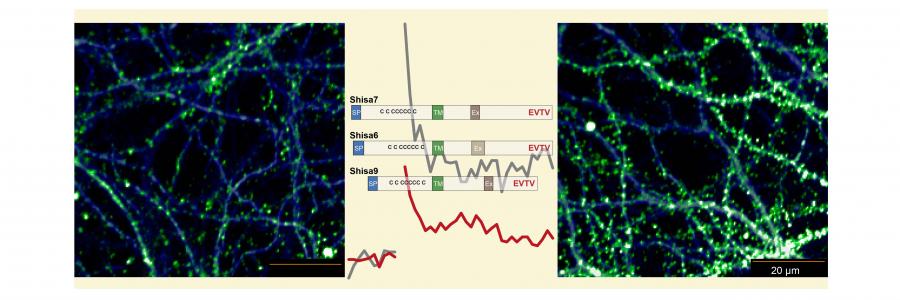
The CNCR ‘Shisa’ team presents the characterization of a yet unknown glutamate receptor auxiliary subunit important for learning and memory. Their findings are currently available in the open access journal eLife.
The ‘Shisa’ team
“In 2010, from our publication of the first member of this family of important proteins in Science, I gathered several colleagues, experts in specific fields, to work on the functional characterization of each Shisa member” explains senior author prof. Guus Smit, head of the CNCR. “Together with PhD students from the labs of prof. Huibert Mansvelder (INF) and prof. Sabine Spijker (MCN), we dissected the role of this Shisa7 protein regarding molecular and physiological function modulating the glutamate receptor and its impact on learning and memory”.
Shisa7 is another auxiliary subunit of the AMPA receptor
The AMPA-type of glutamate receptor is important for fast excitatory communication in the brain, and involved in plasticity processes such as learning and memory. “Thus proteins that regulate the biophysical properties or number of AMPA receptors are similarly important in these processes”, adds Guus Smit. In 2016, we revealed the role of Shisa6 (Klaassen et al., Nature communications), and together with the data of Shisa9, we were now able to distinguish typical overlapping and distinct functions of the Shisa7 protein. Although all proteins interact with the AMPA receptor, each Shisa protein has a specific profile in affecting biophysical properties of the receptor in vitro.”
Shisa7 is another auxiliary subunit of the AMPA receptor
Previously, the authors showed that Shisa6 is important to keep AMPA receptors in the synaptic membrane, where these receptors are protected from losing their ability to signal when synapses are stimulated repetitively (50 Hz). “Interestingly, Shisa7 is not necessary for this type of protection”, explains Huibert Mansvelder. “Rather it is pivotal to keep AMPA receptor communication going under a more extreme plasticity condition called long-term potentiation that is reminiscent of learning and memory processes.”. “Indeed, Shisa7 knock-out mice had difficulties in associative learning and memory”, adds Sabine Spijker. “Although we do not yet know whether Shisa6 deletion affects memory, it is clear that other yet unexplored Shisa family paralogs will have a specific role as intimate AMPA receptor friends in the brain.” Guus Smit concludes “This integrative study argues for the molecular dissection of highly composite AMPA receptor complexes and their function in specific brain areas, something that is the focus of our team for the coming years.”
This paper can be found at eLife
Schmitz, L. J. M., Klaassen, R. V., Ruiperez-Alonso, M., Zamri, A. E., Stroeder, J., Rao-Ruiz, P., et al. (2017). The AMPA receptor-associated protein Shisa7 regulates hippocampal synaptic function and contextual memory. eLife, 6, e24192. http://doi.org/10.7554/eLife.24192
First published online on December 4th, 2017.